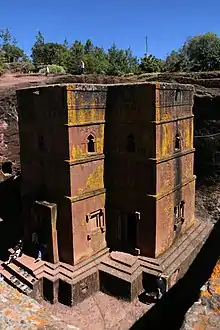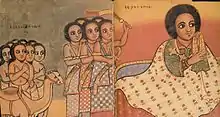Wollo Province
Wollo (Amharic: ወሎ, wellò, originally ቤተ አማራ "Bete Amhara") is a historical region and province in the northeastern part of Ethiopia, with its capital city at Dessie. The Historical name was Bete Amhara "House of Amhara" which districts Lakomelza, Sayint, Mekdela, Tentana, Ambassel, Hayq, Angot (now Raya), Wasal (now Weri Ilu), Kelela

.svg.png.webp)
.svg.png.webp)
There were places in Amhara Wollo province where the belief of Old Testament and synagogues existed before 34 A.D. This region was one of the place where synagogues were transformed into Churches and Churches were became centres of tradition . During the Middle Ages this region was known as Bete Amhara province and had Amhara Kings. Bete Amhara had an illustrious place in Ethiopian political and cultural history. It was the center of Amhara Solomonic Dynasty established by Atse Yekuno Amlak around Lake Hayq 1270, the original center of Amhara people, whose territorial reach extended from Lake Hayq and the Beshillo River in the north, the Afar and Argobba lowlands in the east, the Abbay River in the West, and the Awash River just south of modern Addis Ababa.[1] Today's Wollo was the center of Ethiopia (half under Agew/Zagwe and half under the Amhara/Solomonic leadership). The people of Amhara & Zagwe Province (today's Wollo) were the strongest adherents of Christianity and both believed in Israelite Semetic Biblical Ancestry Agew/Zagwe claimed lineage from Moses while the Amhara/Solomonids claimed lineage from Solomon, and the beliefs and customs of the Church from an essential part of tradition and culture to this area.[2] Believers contend that the monastic life is the highest stage of Christian life. Devout Christians hope to live their last years as monks or nuns, and many take monastic vows during old age. the Monastic school of Lake Hayq founded in 1248 by Aba Iyesus-Mo'a was the fundamental school to Saints, scholars and Christians. The Monasteries spread along with the Ethiopian Empire and Tekle-Haymanot (1215-1313) was trained at Hayq by Iyasus Mo'a and started the important Monastic community of Debre Asbo in Shewa Amhara Debre Libanos, Abune Hirute Amlak was also trained in this Monastery by Iyasus Mo'a and started the imperative Monastic community of Daga Estifanos in Lake Tsana and Aba Georgis Zegasecha trained and started the Monastic community of Gasecha,.[3]

As a result of this, several Church works were performed and it was the land of Saints and Christian kings. Therefore, many famous Churches were built by Christian kings and Monasteries were established by great Saints and wonderful Rock Hewn Churches were carved out of rock. Furthermore, it was the center of Church Education. For example, from the Monastery of Hayq Estifanos the well-known Saints and Christian kings had learnt Church education. For this reason, literature, paintings and other heritages flourished throughout the land. In the region many Rock Hewn Churches were built by Saints like, King Abrha and Astbha/Most of them were in the place of Woleka Debresina but they destructed and hidden during the invasion of Ahmad Gragn/, Aba Betselote Micheal, Aba Giorgis Zegasecha, Aba Tsegie Dengel, Abune Yaekob Zedebrekerbe and by King Lalibela, the rock Church builder - 1140-79 A.D. had a set of ten Rock Hewn Churches built in his capital of Roha, which was later renamed Lalibela. It is also said that he built the Gezaza Abune Gebre Menfes Kidus Church / Gezaza Abbo/ in this region around Wegde. All these are rock hewn Churches carved in solid rock, deserve to be taken as few among wonders and are a remarkable monument to the skill and craftsmanship of the Ethiopians.
Mekane Silasse Church was established before 485 years in 1513 E.C. The foundation was started by Atse Naod /1489-1500/ and it was finished by his son Atse Lebna Dengel /1500-1513/. This Church is different from other Churches because it took twenty five /25/ years to construct it. Atse Naod worked on it for thirteen /13/ years but he died before finishing it. So, his son Lebna Dengel finished it after twelve /12/ years by constructing a great Church and more beautiful than his father. At the inauguration of the Church in 1513 many famous persons were present. Among them, the Portuguese priest and historian writer, Francisco Alvarez was the one who recorded the ceremonies of the Church inauguration at that time. He admired and writes about the Church’s architectural design.
The Church was constructed from Geha /ገሀ/ stone and it had a Mekdes, Kidist and Kine Mahilet. The four sides of the Mekdes and Kidist were equal in size and shape but the shape of the Kine Mahlet was circular. The Church was also much wider and bigger than other Churches of the time found around Wesel.[4] The Portuguese priest and historian writer, Fransisco Alvaraze said the following about its architectural design: “the wall of this Church was made from systematically carved stones / ጥርብ ድንጋይ / and it was designed by a graphic decoration / ሐረግ / …..the door of the main entrance was covered by gold and silver. Inside the gold and silver there were some precious stones. The roof was laid down on the six /6/ columns of the Church and the outer part of the roof was supported by sixty-one /61/ long columns. There were also sixteen / 16/ curtains made of golden cotton cloth.
in the other hand, the historical writer of Ahmad Gragn Arab Faqeh recorded about its architectural design before the destruction of the Church. He admired its construction and architectural design and said that the following: “there was one church in Bete Amhara which no church could imitate in Habesha land".[5] It was constructed by the father of Wenag Seged/ Lebene Dengel/, King Naod. Its work and ornament had taken thirteen /13/ years but king Naod died before finishing it. His son Lebna Dengel finished it after twenty-five /25/ years. He finished the Church by covering all part of it with gold above what his father had done. So the Church reflects like a fire, because, it was covered by gold and all the church holy treasures liturgical objects) / ነዋያተ ቅድሳት / were made from gold and silver. The width of the Church was more than hundred yards /100 ክንድ / and the height was also more than fifty yards /50 ክንድ / ……… Christians called the Church Mekane Silasse……. In this Church, the tomb of Emperor Naod who is the grand son of Zera Yacob and the son of Be’ede Mariam is found.”
| Before Gragn | After Gragn |
|---|---|
| Bete Giyorgis Wesel | Werayilu |
| Genete | Yeju/Guba Lafto |
| Ambassel | Ambassel |
| Amhara Sayint | Borena |
| Akesta | Legambo |
| Beraro | Kalu |
| Mekdela Tentena | Werehimeno |
| Bete Saba | Werebabo |
| Lasta | Lasta |
| Weg | Weg |
| Medir Genye | Kemise |
| Welede | Dawa Chefe |
| Bete | Bate |
| Lakomelza | Desse Zurya |
| Angot | Raya |
| Bete Amhara | Welo |

After-Gragn Before-Gragn
የጁ ገነቴ
ወራይሉ ቤተ-ጊዮርጊስ/ወሰል
አምባሰል አምባሰል (አልተበገረም)
ቦረና አማራ ሣይንት (ላይ ሣይንት አልተበገረም)
ቃሉ ቢራሮ
ላስታ ላስታ ላሊበላ (አልተበገረም)
ዋግ ዋግ (አልተበገረም)
አውሳ ማስዳጎር
ደሴ ዙሪያ ላኮመንዛ/ ወሰል
ወሎ ቤተ-አማራ
At the beginning of TPLF's rule of Ethiopia (between 1991 and 2018), Raya/Angot (i.e. Lasta & Wag) and Welkait were taken away from the Welo and Begemder provinces respectively and given to Tigray.[6] Therefore, until the 1995 administrative reorganization, Raya was part of Welo province. Raya was then split into two parts once ethnic federalism was established in Ethiopia (on 1995). One of the two parts with an Amhara majority (Kobo) went to the new Amhara Region, the other (Raya Azebo) which had a majority of (Tegarus) was given to Tigray Region [7][8][9],.[10][11][12]
With the adoption of the 1995 constitution & the establishment of ethnic federalism system in Ethiopia, parts of the expanded Wollo province, which were mostly inhabited by Afar people were given to the new Afar Region. The new Amhara Region absorbed the remainder of the province in the Ethiopian Highlands and kept the name Wollo for its two new zones (South Wollo Zone & North Wollo Zone).
References
- Alvares, Francisco. (1961). The Prester John of the Indies; a true relation of the lands of the Prester John, being the narrative of the Portuguese embassy to Ethiopia in 1520. Published for the Hakluyt Society at the University Press. OCLC 1636969.
- Abbink, Jon (2016-07-07). "In memoriam Donald Nathan Levine (1931–2015)". Aethiopica. 18: 213–222. doi:10.15460/aethiopica.18.1.936. ISSN 2194-4024.
- Blackhurst, Hector (October 1974). "Church and State in Ethiopia, 1270–1527. By Taddesse Tamrat. Oxford: Clarendon Press, 1972. Pp. xv + 327, bibl., ill., maps. £5·50". Africa. 44 (4): 427–428. doi:10.2307/1159069. ISSN 0001-9720.
- Beckingham, C.F.; Huntingford, G.W.B., eds. (2017-05-15). "The Prester John of the Indies". doi:10.4324/9781315554013. Cite journal requires
|journal=(help) - "Futūḥ al-Ḥabasha". Christian-Muslim Relations 1500 - 1900. Retrieved 2020-12-15.
- This list of provinces is based on the map in Bahru Zewde, A History of Modern Ethiopia (London: James Currey, 1991), p. 86.
- "Bernard Leeman, THE REALM OF D'MT - ONE AND THE SAME AS QUEEN YODIT'S DAMOT?".
- Shaw, Thurstan (1995), The Archaeology of Africa: Food, Metals and Towns, Routledge, p. 612, ISBN 978-0-415-11585-8
- "The British Museum, "The wealth of Africa:- The kingdom of Aksum"" (PDF).
- Bereket Habte Selassie, "Constitutional Development in Ethiopia", Journal of African Law, 10 (1966), p. 79.
- "Sarah Vaughan, "Ethnicity and Power in Ethiopia", PhD dissertation, p. 123, 2003" (PDF).
- The 1994 Population and Housing Census of Ethiopia Results for Tigray Region. 1. Addis Ababa: Central Statistical Authority. 1995. p. 70.